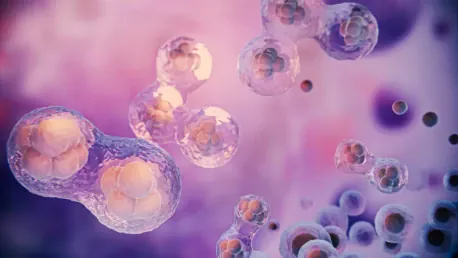Lambert-Eaton myasthenic syndrome (LEMS) is a rare and debilitating autoimmune disorder where the immune system mistakenly attacks the body’s own tissues, specifically targeting voltage-gated calcium channels (VGCCs) on nerve cells. This disruption in nerve-muscle communication results in muscle weakness and other severe symptoms that can significantly impact daily life. Traditional treatments involve immune-suppressing or immunomodulatory therapies, but these approaches often fall short, especially in cases that are particularly severe, leaving patients with few viable options.
The Challenge of Treating Severe LEMS
Traditional Therapies and Their Limitations
Patients with severe LEMS often endure substantial muscle weakness, making everyday activities incredibly challenging. Treatments typically include corticosteroids, rituximab, and plasma exchange therapy, all aimed at reducing the autoimmune attack on the nervous system. Symptomatic treatments such as Firdapse (amifampridine) are commonly used to help alleviate immediate symptoms by improving muscle strength. However, these therapies are frequently inadequate, leaving patients struggling with persistent weakness and limited ability to perform daily tasks. This shortfall in effective treatment underscores the urgent need for new therapeutic strategies for managing hard-to-treat LEMS cases.
Case Study: A 54-Year-Old Man’s Struggle
A recent case study from Germany illustrates the struggles faced by individuals with severe, idiopathic LEMS. The study centered on a 54-year-old man who, despite several rounds of treatment with corticosteroids, rituximab, and plasma exchange, continued to suffer from significant symptoms. His condition was marked by extreme difficulty in moving his limbs and a severe limitation in walking, only managing about 36 feet with a walker. Additionally, he required assistance with basic daily activities such as rolling over in bed and shaving. The persistence of these symptoms highlighted the inadequacy of existing therapies for managing his condition, making a compelling case for exploring alternative treatments like CAR T-cell therapy.
Exploring CAR T-Cell Therapy for LEMS
Introduction to CAR T-Cell Therapy
CAR T-cell therapy is an innovative form of immunotherapy that involves collecting a patient’s T-cells, modifying them in a lab to express a chimeric antigen receptor (CAR) targeting a specific protein, and then reinfusing these engineered T-cells back into the patient. For LEMS, the target protein is CD19, found on B-cells, which are responsible for producing antibodies that attack VGCCs. Originally developed for treating CD19-positive blood cancers, anti-CD19 CAR T-cells have now shown potential in treating autoimmune diseases, suggesting a new frontier in managing conditions where traditional therapies have proven to be inadequate.
Application in Autoimmune Diseases
The anti-CD19 CAR T-cells were initially designed to combat blood cancers by targeting CD19 on cancerous B-cells, effectively eliminating them. Researchers have recognized that similar principles could be applied to autoimmune diseases driven by antibodies, such as LEMS. This innovative approach is particularly promising for autoimmune conditions that are unresponsive to conventional therapies. The case of the 54-year-old man provides a compelling example of this potential. By targeting the B-cells producing harmful antibodies, CAR T-cell therapy can potentially alleviate the autoimmune attack, offering significant clinical benefits where other treatments have failed.
The Case Study: A Turning Point
Initial Treatment and Side Effects
Before receiving CAR T-cell therapy, the patient first underwent chemotherapy to deplete his existing immune cells, creating space for the modified T-cells. Shortly after the CAR T-cells were infused, the patient developed cytokine release syndrome (CRS), a common inflammatory side effect characterized by fever and general malaise. This temporary worsening of his LEMS symptoms was expected and managed appropriately. The CRS resolved within weeks, allowing the patient to be discharged from the hospital two weeks after the treatment, ready to observe the longer-term effects of the engineered T-cells on his condition.
Remarkable Improvement
After the initial period of side effects, the patient’s condition began improving significantly. Within a month of receiving CAR T-cell therapy, he gained the ability to roll over in bed and shave independently—tasks that previously required assistance. Moreover, his mobility saw a remarkable enhancement, enabling him to walk up to 90 meters (approximately 300 feet) with a walker, marking an eightfold increase in his walking distance compared to his pre-treatment capabilities. This rapid improvement was echoed by researchers who noted substantial amelioration of LEMS symptoms within three months of the CAR T-cell infusion, highlighting the therapy’s potential efficacy.
Implications for Future Treatment
Efficacy and Safety Profile
The study underlines that anti-CD19 CAR T-cell therapy not only produced good efficacy in improving the patient’s condition but also maintained an acceptable safety profile. The rapid and noteworthy improvement observed suggests that this therapy could be a viable treatment option for managing severe LEMS, especially in cases where traditional therapies have failed. Given the potential benefits and relative safety observed in the case study, anti-CD19 CAR T-cell therapy presents itself as a promising approach for similar autoimmune diseases, pushing the boundaries of current treatment paradigms.
Broader Therapeutic Applications
The success story of CAR T-cell therapy in treating severe LEMS supports a growing trend of utilizing this technology beyond its original oncological applications. This approach has significant implications for various autoimmune conditions that are difficult to manage with traditional treatments. By re-engineering immune cells to precisely target specific proteins implicated in disease pathology, CAR T-cell therapy offers a new horizon for patient care. It provides hope to those suffering from severe autoimmune diseases, potentially transforming the treatment landscape and improving the quality of life for many individuals.
The Need for Continued Research
Advancing Cellular Therapies
The compelling case of CAR T-cell therapy in treating refractory LEMS highlights the pressing need for innovation in addressing autoimmune conditions that do not respond well to existing therapies. This described research has contributed significantly to understanding that CAR T-cell therapy might extend beyond oncology, presenting a viable option for patients seeking relief from severe autoimmune diseases. As cellular therapies continue to evolve, they offer a promising horizon for patients who have found little solace in traditional treatment avenues.
Future Studies and Validation
Lambert-Eaton myasthenic syndrome (LEMS) is an uncommon and severe autoimmune disorder in which the immune system erroneously targets the body’s own tissues. This disorder specifically attacks the voltage-gated calcium channels (VGCCs) located on nerve cells. As a result of this attack, the communication between nerves and muscles is disrupted, leading to muscle weakness and other serious symptoms, which can profoundly affect an individual’s daily life. The standard treatments for LEMS usually involve immune-suppressing or immunomodulatory therapies aimed at reducing the immune system’s attack on the VGCCs. However, these treatment methods often prove inadequate, especially in the most severe cases. This leaves patients with limited and often unsatisfactory options for managing their condition. The quest for more effective treatments continues, with ongoing research focused on finding better ways to alleviate the symptoms of LEMS and improve the quality of life for those affected by this challenging illness.









